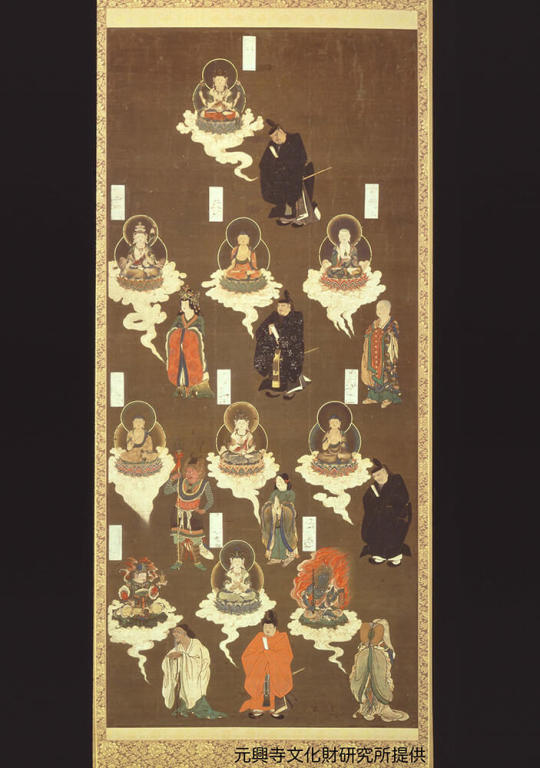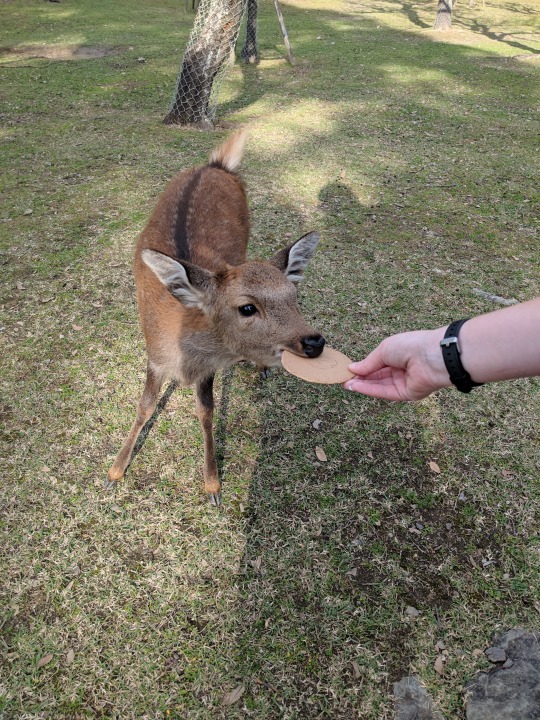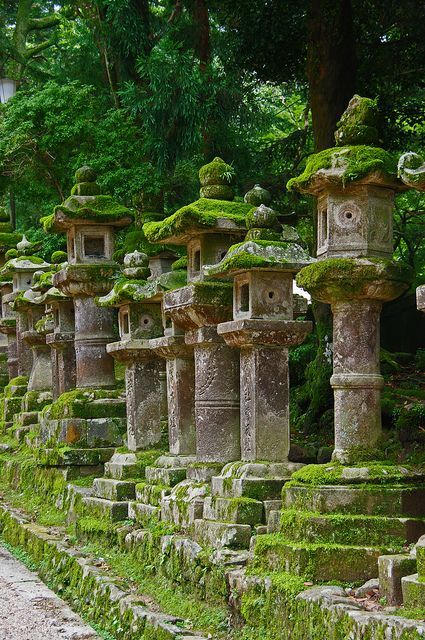#kasuga grand shrine
Explore tagged Tumblr posts
Photo

A hanging scroll of the Kasuga Mandara (春日曼荼羅), a mandala depicting the Buddhist deities thought to manifest as the local Kasuga deities at Kasuga Taisha Shrine (春日大社)
Color on silk dating to the 14th century from the collection of Hōzanji Temple (宝山寺) in the Monzenmachi neighborhood of Ikoma, Nara Prefecture
Image from the Ikoma City Digital Museum
#japanese religion#japanese art#buddhist art#曼荼羅#mandala#奈良県#nara prefecture#生駒市#ikoma#宝山寺#hozanji#真言律宗#shingon ritsu#春日大社#kasuga taisha#kasuga grand shrine#春日曼荼羅#kasuga mandara#hanging scroll
15 notes
·
View notes
Photo



The deer 100% do not care unless you have senbei and will aggressively follow you if they know you have crackers and don't hand them over. They are cute though.
Watch this for your safety! 了解鹿 나라의 사슴을 알자
注意 Warning 警告 주의
奈良公園のシカの多く人に慣れていますがあくまで野生動物です。時として1人を攻撃することがありますので、特にご高齢の方や��さなお子様連れの方は注意してください。 The deer of Nara Park are wild animals. They can occasionally attack people, so please be careful. 奈良公园的鹿属于野生动物、有时会攻击人、所以凊注意安全。 나라공원에 있는 사슴은 야생 동물입이다. 때로는 사람을 공격하기도 하므로 주의하여 주시기 바랍니다.
かむ Bite 咬人 문다
たたく Kick 踢人 때린다
突く Butt 顶人 들이받는다
突進 Knock down 冲撞人 돌진
奈良県 奈良市 春日大社 奈良の鹿愛護会 連絡先 奈良公園のシカ相談室 TEL 0742-26-7755
Japanese あくまで after all, it must be remembered, simply 突く (つく) to attack 突進 (とっしん) rush, dash, charge 春日大社 (かすがたいしゃ) Kasuga Grand Shrine 愛護 (あいご) protection, tender care
Korean 사슴 deer 야생 wild, feral 때로 sometimes, occasionally 공역하다 to attack
47 notes
·
View notes
Text

Kasuga Taisha Shrine, Nara, Japan Kasuga Grand Shrine (春日大社 Kasuga-taisha?) is a Shinto shrine in the city of Nara, in Nara Prefecture, Japan.[1] Established in 768 AD and rebuilt several times over the centuries, it is the shrine of the Fujiwara family. The interior is famous for its many bronze lanterns, as well as the many stone lanterns that lead up the shrine. The architectural style Kasuga-zukuri takes its name from Kasuga Shrine's honden (sanctuary). Kasuga Shrine, and the Kasugayama Primeval Forest near it, are registered as a UNESCO World Heritage Site as part of the "Historic Monuments of Ancient Nara". The path to Kasuga Shrine passes through Deer Park. In Deer Park, deer are able to roam freely and are believed to be scared messengers of the Shinto gods that inhabit the shrine and surrounding mountainous terrain. Kasuga Shrine and the deer have been featured in several paintings and works of art of the Nambokucho Period.[2] Over a thousand stone lanterns line the way. The Man'yo Botanical Garden, Nara is adjacent to the shrine. (Wikipedia EN: en.wikipedia.org/wiki/Kasuga-taisha )
17 notes
·
View notes
Text
May 29: Nara
Today we went to Nara to see Todai-Ji and Kasuga Taisha shrine, as well as to see the famous (and friendly!) Nara deer. I absolutely loved our day trip, and it is easily one of my favorite excursions overall. When we got there, I was absolutely amazed at how many deer there were and how they simply lounged around like pigeons in the park. They were super pushy though, I didn’t feed them because I really wasn’t in the mood to get bit. After hanging out with the deer for a bit, we went to the Kasuga Taisha shrine. This shrine is famous for its lanterns, and even though it wasn’t nighttime we were still able to go to a dark room and view them. Then, we went to the nearby Todai-Ji temple, which is the largest wooden building in the world! It truly was a wonder to see, and I felt dwarfed by the sheer size of it, and the size of the buddhas within. It was gorgeous, and something I wish my mom could have come with me to see. Maybe next time I go to Japan I can show her!
When I was at Todai-Ji, I definitely got the impression that the building was at least partially an expression of power. There was opulence from the golden accents on the buddhas to the sheer size of everything within the temple. As the stated in discussion, there is no debate that this was extremely labor intensive and an expression of power. I also noticed that there were several different Buddha present at the temple, all an extension of the Vairocana Buddha. After seeing the bronze statue in person, I can certainly understand the feeling of safety one can get from having a Buddha as grand as that helping mankind reach enlightenment.
One thing I noticed at the temple and shrine that we visited was the mixing of the two religions. While we were at Kasuga Taisha shrine, there were Buddhist monks praying to the Shinto gods. This is likely because most divisions of Buddhism agree that Shinto gods are manifestations of Buddha. I also believe I saw someone in shrine wear at the Buddhist temple as well. These two religions, as we have read in the readings and have seen throughout Japan, are so intertwined that it’s no wonder that most people in Japan practice both.




0 notes
Text

Ō-yoroi, Kamakura period, 13th-14th century, National Treasure, Kasuga Grand Shrine.
1 note
·
View note
Text
Stone lanterns at Kasuga Grand Shrine in Nara, Japan

1 note
·
View note
Text
Visiting Kasuga Shrine: Primeval Forests and Fujiwara Power
On our recent trip to Kyoto and Nara, we spent our last morning in Nara visiting the venerable Shinto shrine called Kasuga Taisha (春日大社), or Kasuga Grand Shrine (English / Japanese). The English site doesn’t really explain the history or significance of the shrine though. Kasuga, along with neighboring the Buddhist temple of Kofukuji, were centers of power for the elite Fujiwara clan. Both the…

View On WordPress
0 notes
Photo

Stone lanterns at Kasuga Grand Shrine in Nara, Japan
1 note
·
View note
Photo

Stone lanterns at Kasuga Grand Shrine in Nara, Japan
0 notes
Text
Day 8 - Nara

We didn’t stay long in Osaka, instead quickly heading off to Nara, where we first visited Kofukuji temple, where we first encountered some of the Nara deer. The ones here were rather calm, just lying and walking around, not really minding the people coming up to pet them, however we learned on our way to Kasuga Grand Shrine that not all the deer in Nara are so laid back. We walked through a park on the way there, and several of us bought cookies to feed the deer. As soon as one of us would buy them, the deer would swarm around that person, trying to get the food. I was amused the experience, but some people found it a bit overwhelming, especially when the deer tried testing if parts of our bags and clothes were also edible.


It was interesting to see how the people who live in Nara interact with the deer, since they see them on a daily basis. The people selling the deer cookies mostly ignored them, and we noted that although the vendors had the cookies right there, the deer didn’t bother them, only getting excited once the vendor handed the cookies to the customer. Outdoor facilities in areas with a lot of deer also didn’t seem to pay attention to them much, as I saw a couple places that just had deer standing in the doorways and walking between tables. As we got closer to the shrine, we noticed that the behavior of the deer changed, with many of them bowing to people to ask for treats. I wonder if they’ve always done that, learning from people praying at the shrine and greeting each other, or if it’s a more recently learned behavior since tourism started booming in Japan.


The last place we visited was Todaiji, which houses a 15-meter-tall Buddha statue. The size of it is almost incomprehensible, even while you’re standing in front of it. No pictures can do it justice. There were many school children of all ages on trips to the temples and shrines that day, and it’s a good reminder that these places we visit aren’t there simply for foreign tourists. Although tourism and monetization has become a big part of temples and shrines in Japan, they’re also there for the people of Japan who believe in and practice Buddhism and Shinto, even if most people only practice on occasion.

0 notes
Text
16/5
Kofukuji
Located in Nara close to Osaka, this was a big temple grounds with few deer unlike later on, but everyone was smitten with them lol.
On its grounds was a replica building that was completed in 2017. There was a museum that we visited that housed more wooden sculptures of the Buddhist deities and once again another main building that housed the main buddha and its four generals or so.
In total we visited two buildings here and some deer.
Todaiji
This is one of the bigger Buddist halls in Japan, with one of the biggest Buddhas in the world. Like many locations there has been a part or aspect of the building that has been rebuilt.
There were more deer on this side of the park. There were also lots of students, more than usual, according to my teacher, which I suppose is the cause of the rain from the last two days.
My teacher asked if I understood why there was such a strong sense of Buddhism and for why the students visited this place on school trips.
Kasuga Grand Shrine
Located at the far, far end of the Nara deer park. Unlike the previous two spots, this one was primarily Shinto related. This location is known for its lantern hall, which involves lanterns different from those outdoors in a pitch black room filled with mirrors giving an infinite atmosphere of elevation.
0 notes
Text

A depiction of Kasuga Myōjin (春日明神), one of the deities of Kasuga Taisha Grand Shrine (春日大社) in Nara, dressed in court robes and sitting in a carriage with his face obscured by clouds, with the corresponding Buddhist deities of the shrine displayed above
Color on silk dating to the Kamakura period (1185-1333), painted by Takashina Takakane (高階隆兼), from the collection of the Fujita Art Museum (藤田美術館) in Osaka
Image from "Shintō: The Sacred Art of Ancient Japan" edited by Victor Harris, published by the British Museum Press. 2001, page 169
#japanese art#buddhist art#春日明神#kasuga myojin#春日大社#kasuga taisha#高階隆兼#takashina takakane#大和絵#yamato e#yamato-e#crazyfoxarchives#arte japonés#arte budista
23 notes
·
View notes
Text

















Day 8
Tu 5/16 Osaka ► Nara ֍ Kofukuji ֍ Todaiji ֍ Kasuga Grand Shrine [Daiwa Roynet Hotel Nara]
On day 8 we left Osaka to go to Nara. At Nara, we see a lot of Japanese students gathering in groups. We were thinking that this could be their end-of-year field trip too. We all ended up walking together to the Kofukuji temple. On our way there we see a lot of deer of both gender and sizes. We heard that deer is a sacred animal of Nara and the people here take very good care of them which helps their population expand significantly. Now a day deer become a major tourist attraction in Nara. Along the road leading up to Kofukuji temple, one can see many stand that sell deer food for tourist to feed to the deer in this area. Although the majority of the deer are very kind, some of them can also be very aggressive. Some of us got bit by them but the wound was not anything serious. We also saw many people being chased by the deer not knowing what to do because they weren’t prepared to be surrounded by them. Lastly, we also see some deer bowing back to us as we bow to them. That was one of the cutest things I ever saw in my life, so cute that I have to buy the deer plushie of the mascot of Nara. I noticed that there are yuru characters everywhere representing the location and I thought that it was so interesting to see the modern popular culture influenced the traditional spot of Japan.
Afterward, we all go to the Kasuga Grand shrine and there were more deer here as well. Some were lying under the grand tree inside the shrine. That was a relaxing sight. At the shrine, there are a lot of lanterns and there’s also a dark room with a lot of beautiful lanterns. At first, I thought it was just a candle burning inside the lantern but maybe it was electricity. Since now a day a lot of traditional places like shrines also become more modernized.
By the end of the day the last place we visited was Todaiji. This is where we get to see a large Buddha statue. I’m a Buddhist, but ever since I moved to the U.S., there was not a lot of opportunity to go to the temple. This is why when I get to go to Buddhist Temple in Japan it connected me with my religion and reminded me of all the temples in my hometown growing up. During this trip, I also have many chances to connect to my religion through these temples this help me realized that it had been a very long time since I last connected with my religion. This in a way reminds me to find more opportunities to go to Temple even in America.
0 notes
Photo










Kasuga Grand Shrine, Nara, Japan [via]
5 notes
·
View notes
Photo

奈良にある春日大社でひけるおみくじです。
#photo#nara#deer#japan#fortune#写真#鹿#奈良#日本#おみくじ#春日大社#Kasuga Grand ShrineKasuga Grand Shrine#Kasuga Grand Shrine
5 notes
·
View notes
Video
Night at Kasuga Shrine por ScottSimPhotography Por Flickr: Nara Rurie festival at Kasuga Grand Shrine. ◦ なら瑠璃絵 ● Sony a6000 ● E PZ 16-50mm
#japan#japanese#asia#asian#kansai#nara#kyoto#shrine#kasuga#grand#taisha#forest#enchanted#wood#illuminations#illuminated#magical#mysterious#famous#visit#travel#UNESCO#rurie#なら瑠璃絵#奈良#奈良公園#春日大社#春日#春日山原始林#kit lens
17 notes
·
View notes